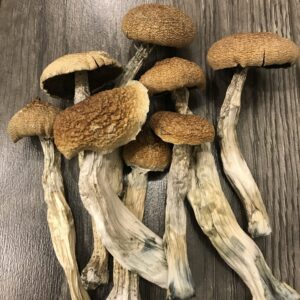
DESCRIPTION
Blue Meanie Mushroom Strain. Blue Meanie Mushroom” is a name applied to at least two different mushrooms. One is a strain of Psilocybe cubensis. The other is the species Panaeolus cyanescens which is consider the “real” Blue Meanie. Both are psychoactive and sometimes used recreationally or medicinally, but it’s important not to confuse the two (though be careful, as some writers do mix them up). For one thing, Panaeolus cyanescens is dramatically more potent and therefor requires different dosing guidelines. Here we’re going to talk about Blue Meanie, the Psilocybe cubensis strain.
There are many cultivated strains of Psilocybe cubensis, some of them collected from the wild and some developed by growers. Blue Meanie is thought to be one of the former, having been collected from Australia. It does, indeed, bruise bluish if handled, but it’s not especially mean (it’s also not at all Meanie-like, a reference those who have seen the movie, Yellow Submarine, will understand).
Psilocybe cubensis, and all its various strains, is what people usually mean by phrases like “shrooms” or “magic mushrooms.” It’s not the only hallucinogenic mushroom species around—there are dozens of others that likewise contain significant amounts of psilocybin, plus some of the Amanitas contain a very different psychoactive substance, moscimol—but it may be the most popular. It grows wild across much of the world and feeds on the dung of mammals (it can be cultivated on other substrates, though). Its fruiting bodies are typically medium-sized with light-brown caps and a webby partial veil that tears just before spore release. But there is a lot of natural variation in color, size, cap shape, and psilocybin concentration.
There is some debate about whether different strains produce different kinds of trip. Certainly, trip experiences vary widely, but at least part of that is due to variation in the biochemistry of the users, as well as the specifics of their set and setting. Some people say that a cube is a cube, and that while the strains differ from each other in potency, their trips have no consistent, recognizable character apart from their identity as Psilocybe cubensis.
Blue Meanie fruits prolifically, though the individual mushrooms are not especially large. Colonization time is relatively short. There are no particular guidelines for growing this strain, as it does well in all of the methods usually used for P. cubensis. The only caveat is that whatever method a grower users, it’s important to do the method properly. Follow the instructions. Hybrid methods or sloppiness usually yield poor results. Blue Meanie is considered one of the easier strains to grow.
Blue Meanie Mushroom Strain
Sellers sometimes suggest dose sizes (for example, one gram, in the case of Blue Meanie), but really it’s not that simple. Is the user a newbie who wants a very light, introductory dose? An old hand who wants to get as high as possible? A microdoser? And is the mushroom dry or fresh (fresh includes a lot of water-weight, so the dose will be bigger)? Is the user big or little? A rough estimate for P. cubensis dosage can be calculated, but since both user sensitivity and mushroom potency vary, the result is only approximate.
Everything else being equal, a Blue Meanie dose will be smaller than average, since it is known to be a very potent strain.
Blue Meanie is considered among the most potent P. cubensis strains, with a high that is visual, physical, euphoric, energetic, and introspective. The trip usually begins anywhere from forty-five minutes to an hour after ingestion, though since the effects can go on intensifying for some time, users are advised not to take any more until at least three hours after the first dose. Trips can last four to five hours.
Blue Meanie Mushroom
